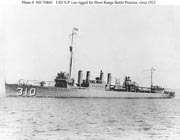The Day in History: Honda Point Disaster (1923)
The Honda Point Disaster was the largest peacetime loss of U.S. Navy ships. On the evening of September 8, 1923, seven destroyers, while traveling at 20 knots (37 km/h), ran aground at Honda Point, a few miles from the northern side of the Santa Barbara Channel off the California coast. Two other ships grounded, but were able to maneuver free of the rocks. Twenty-three sailors died in the mishap.
Geography of Honda Point
The area of Honda/Pedernales Point is extremely treacherous for Central California mariners in that it features a series of rocky outcroppings (one of which is today named "Destroyer Rock") sticking out about one-quarter mile, called the "Devil's Jaw", that has been a navigational hazard since the Spanish explorers first came in the 1500s. Also, this is near the entrance to the sometimes treacherous Santa Barbara Channel, a popular shipping shortcut for vessels going to and from the ports of Southern California, that is 12-25 miles wide between the coast and the Channel Islands. The problem with the entrance to the channel is it is one of the windiest places for mariners to go through on the West Coast. Many times winds and waves are so vicious that vessels will ride the storm out at San Miguel Island's small harbor, or waves ranging from 20-30 feet high will force the harbors at Santa Barbara, Ventura, Port Hueneme, and Oxnard to close. The entrance to the Channel acts like a vortex, sucking the winds of Pacific storm systems into the passage. The most dangerous area is from Point Pedernales east, along the stretch of forlorn south-facing coast (much of which is now part of the Vandenberg AFB Western Launch and Test Range), to Gaviota Creek, where U.S. 101 meets the coast from the Santa Ynez Valley. Vessels can be blown ashore, or with the dense fog that is common on the California Central Coast in the summer, ships can simply run aground when they lose track of their location.

The incident
The fourteen ships of Destroyer Squadron 11 (DESRON 11) made their way south from San Francisco Bay to San Diego Bay in the late summer of 1923. The squadron was led by Commodore Edward H. Watson, on the flagship leading the squadron. All were Clemson-class destroyers, less than five years old. The ships turned east to course 095, supposedly into the Santa Barbara Channel, at 21:00.
The ships were navigating by dead reckoning, estimating their position by their heading and speed, as measured by propeller turns. At the time radio navigational aids were new and not completely trusted. Delphy was equipped with a radio navigational receiver, but ignored the bearings, believing them to be erroneous. No effort was made to take soundings or depth measurements. These operations were not performed due to the need to slow the ships to take readings. The ships were performing an exercise that simulated wartime conditions, hence the decision not to slow down. In this case, the dead reckoning was wrong and the mistake fatal.
Earlier the same day, the mail steamship Cuba ran aground nearby. Some attributed these incidents in the Santa Barbara Channel to unusual currents caused by the Tokyo earthquake of the previous week.
Source:
Source: encyclopedia.thefreedictionary.com
Other Links:
The Day in History: Battle of Moh?cs Begins (1526)
The Day in History: Fort Mims Massacre (1813)
The Day in History: Iroquois Confederacy Is Formed (1142)